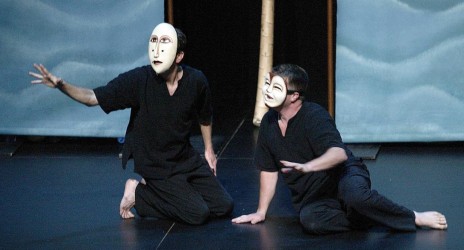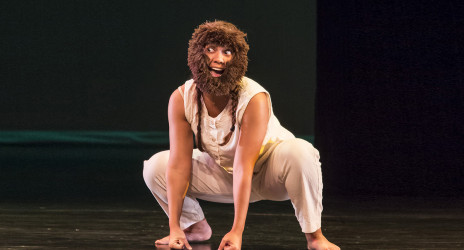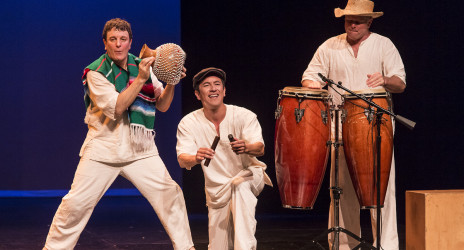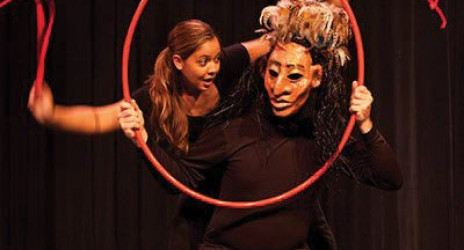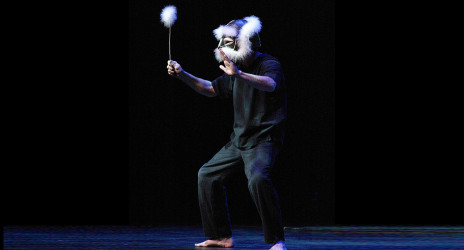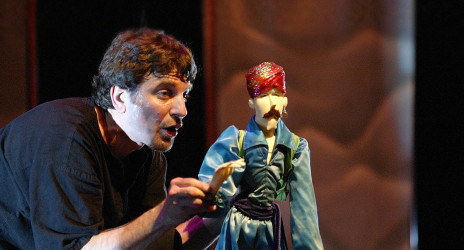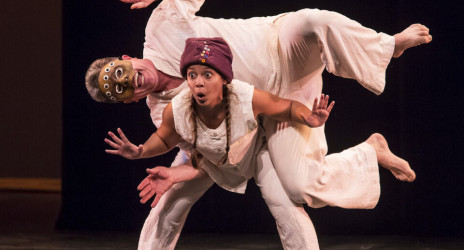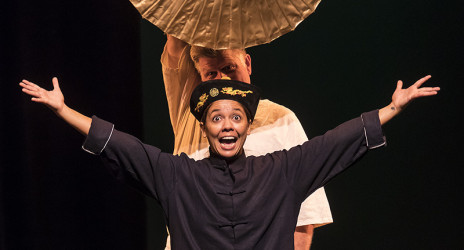WISDOM OF EMOTIONS – Life Lessons from Around the World This show features myths, folktales, and music from different cultures that were chosen with Social Emotional Learning (SEL) in mind. The stories offer examples of the 5 SEL competencies of: self-awareness, self-management, social awareness, responsible decision-making, and relationship skills. The stories include: The Hunterman and the Crocodile – Africa (Responsible decision-making & Social awareness) Donso, the Hunterman, agrees to return Bamba, the Crocodile to his home in the river if the crocodile promises not to bite him. Yet once there, the crafty creature decides he’s too hungry to let the hunter go. One by one, animal passers-by refuse to rescue Donso, explaining how Man has exploited their species, taking much from them and giving back nothing. In the end, Donzo learns that we all need each other, so we need to figure out a way to get along. Also, by listening to the animal’s stories that day, Donzo learned to have respect and empathy for others, and from that time on, he tried to treat others as he himself would like to be treated. Sealskin Soulskin – Inuit/Pacific Northwest (Self-Awareness, Self-Management & Relationship Skills) A …
WISDOM OF EMOTIONS – Life Lessons from Around the World This show features myths, folktales, and music from different cultures that were chosen with Social Emotional Learning (SEL) in mind. The stories offer examples of the 5 SEL competencies of: self-awareness, self-management, social awareness, responsible decision-making, and relationship skills. The stories include: The Hunterman and the Crocodile – Africa (Responsible decision-making & Social Awareness) Donso, the Hunterman, agrees to return Bamba, the Crocodile to his home in the river if the crocodile promises not to bite him. Yet once there, the crafty creature decides he’s too hungry to let the hunter go. One by one, animal passers-by refuse to rescue Donso, explaining how Man has exploited their species, taking much from them and giving back nothing. In the end, Donzo learns that we all need each other, so we need to figure out a way to get along. Also, by listening to the animal’s stories that day, Donzo learned to have respect and empathy for others, and from that time on, he tried to treat others as he himself would like to be treated. Sealskin Soulskin – Inuit/Pacific Northwest (Self-Awareness, Self-Management & Relationship Skills) A lonely man …
B’RER RABBIT AND OTHER TRICKSTER TALES This 40-minute digital assembly inspires self-reliance and creative problem solving on a humorous and magical journey with wily creatures who teach us folk wisdom, and life lessons in this collection of trickster tales from around the world. Stories include: Brer Rabbit, Brer Alligator and Trouble (Southern U.S.) features B’rer Rabbit and B’rer Alligator. In the story, B’rer Alligator says he has never known any trouble in his life and he is curious as to what it is. B’rer Rabbit brings trouble to him, and B’rer Alligator not only gets a new coat, but learns a valuable lesson: “Never trouble trouble unless trouble troubles you.” Tio Conejo (Venezuela, bilingual) is the story of B’rer Rabbit’s Mexican cousin, Tio Conejo “Uncle Rabbit.” Although Tio Conejo is smarter than all the other animals, he also is smaller and often picked on by the other, larger animals. He does not like being smaller so appeals to the great maker in the sky to make him bigger. The great maker in the sky agrees to make Tio Conejo bigger if he can pass a test; he is to capture three ferocious animals in one day. Tio Conejo accomplishes the task and …
LEYENDAS DE DUENDE This bilingual production explores the rich Hispanic folklore and mythology of Latin America. The stories include La Calavera from Mexico, and Paco and the Witch from Puerto Rico. The program also includes an Afro/Cuban Rhythm and Song that calls to “Alegua – the trickster of the crossroads”, from the Afro-Cuban tradition of Santeria. La Calavera After using up everyone in his small village, an old father ventures out onto the road to find a godparent for his 12th child. He’s approached by Papa Dios and El Diablo, as well as a host of pre-Columbian deities who offer themselves for the job before he chooses Godmother Death (La Calavera), as she seems the most just, not favoring the rich over the poor. Calavera teaches the boy to be a great healer, and he grows up to be rich and famous, but in the end, when the healer tries to cheat death, Calavera shows him no special favor. Paco and the Witch Paco is a good boy who likes to help his mom but when he goes to town to run an errand he has to pass through the dark forest where a bruja, or witch, is waiting to snatch …
LEYENDAS DE DUENDE This bilingual digital assembly explores the rich Hispanic folklore and mythology of Latin America. The stories include La Calavera from Mexico, and Paco and the Witch from Puerto Rico. The program also includes an Afro/Cuban Rhythm and Song that calls to “Alegua – the trickster of the crossroads”, from the Afro-Cuban tradition of Santeria. La Calavera After using up everyone in his small village, an old father ventures out onto the road to find a godparent for his 12th child. He’s approached by Papa Dios and El Diablo, as well as a host of pre-Columbian deities who offer themselves for the job before he chooses Godmother Death (La Calavera), as she seems the most just, not favoring the rich over the poor. Calavera teaches the boy to be a great healer, and he grows up to be rich and famous, but in the end, when the healer tries to cheat death, Calavera shows him no special favor. Paco and the Witch Paco is a good boy who likes to help his mom but when he goes to town to run an errand he has to pass through the dark forest where a bruja, or witch, is waiting …
THE HERO TWINS This bilingual digital show based on the The Popol Vuh which is the central creation myth of the Quiche Maya people of Central America. It tells the story of Hero Twins who journey down to the Underworld to be tested by and eventually defeat the evil Lords of Xibalba, avenging the death of their father, and clearing the path for human beings to arrive on Earth. The story is filled with magic, a close connection to the animal world and the struggle between life and death. Like Homer’s Odyssey, it is one of the world’s great “Hero’s Journey” tales. Acknowledgements Photos by David Bazemore and Isaac Hernandez. Directed by Sigfrido Aguilar, Joseph Velasco and the Boxtales Theatre Company. Written by the Boxtales Theatre Company. Masks by Lesley Finlayson, Lindsay Rust and Anne Chevrefils. Shadow Puppets by Rudy Martinez. Lighting by Chris Turner.
WATERS OF THE EARTH This 60-minute digtital assembly explores the rich folklore and mythology of seafaring peoples from all over the globe. Waters of the Earth also includes an introduction to the tradition of Sea Chanteys, songs sung by working sailors on all kinds of ships. Songs from Irish, New England, and African American/Afro Caribbean traditions will be taught and sung during the performance. Sealskin Soulskin In this story, a lonely man steals the sealskin of a Selkie (a seal-woman.) When she asks for the skin back the man refuses to return it unless she marries him and lives with him for seven years. She agrees and eventually they grow to love one another and have a child together, a boy. Eventually, the woman becomes ill and crippled and in the eighth year, she demands her skin returned to her. The man becomes angry and refuses for fear she will leave him and return to the sea. After the man storms out, the boy is summoned by a mysterious ocean spirit to where the sealskin is hidden. He returns the skin to his mother and they both plunge into the ocean to meet with the wise old Grandfather Seal. The …
WATERS OF THE EARTH This 40-minute digital assembly explores the rich folklore and mythology of seafaring peoples from all over the globe. Waters of the Earth also includes an introduction to the tradition of Sea Chanteys, songs sung by working sailors on all kinds of ships. Songs from Irish, New England, and African American/Afro Caribbean traditions will be taught and sung during the performance. Sealskin Soulskin In this story, a lonely man steals the sealskin of a Selkie (a seal-woman.) When she asks for the skin back the man refuses to return it unless she marries him and lives with him for seven years. She agrees and eventually they grow to love one another and have a child together, a boy. Eventually, the woman becomes ill and crippled and in the eighth year, she demands her skin returned to her. The man becomes angry and refuses for fear she will leave him and return to the sea. After the man storms out, the boy is summoned by a mysterious ocean spirit to where the sealskin is hidden. He returns the skin to his mother and they both plunge into the ocean to meet with the wise old Grandfather Seal. The …
JAMBO WATOTO This digital assembly is a loving homage to the rich and wonderful cultures of Africa. Featuring stories and traditional rhythms from different regions of Africa including How Ananse Gained a Kingdom of Knowledge from a Kernel of Corn (Ashanti) and The Hunterman and the Crocodile (Donso, West Africa). The Hunterman and the Crocodile Donso the hunter-man, against his better judgment, agrees to carry Bamba the Crocodile back to his home in the river. After carrying Bamba into the water and releasing him, Bamba takes hold of his arm, to make Donso his next meal. As they argue, about right and wrong and how a good deed should be repaid, they float by a cow, a horse, a chicken, and an old mango tree, and Donso begs them all to help. They all refuse and say that he deserves to be eaten by the Bamba. Finally, a clever rabbit approaches and plays a trick on the Bamba to help free Donzo. Once they’re out of the river and Bamba is back up on Donso’s back, the tables are turned and the rabbit suggests that he take Bamba home to his wife “to make a great meal.” On his way …
THE STONECUTTER (Chinese Folktale) A stonecutter is envious of rich people. An angel turns him into a rich man. But he keeps finding things he’d rather be. He’d rather be king, a farmer, the sun, a cloud, the wind, a mountain. While he’s a mountain a stonecutter comes by and starts to chip away at him. The pain is too much for him to bear. He realizes that being a stonecutter was best after all. Be happy with who you are, you don’t need to look around and be envious of others. Acknowledgements Photos by David Bazemore. Directed by James Donlon and Boxtales Theatre Company. Written by Boxtales Theatre Company. Masks by Ann Cheverfils. Lighting by Tony Mangini. Video produced by David Bazemore.

